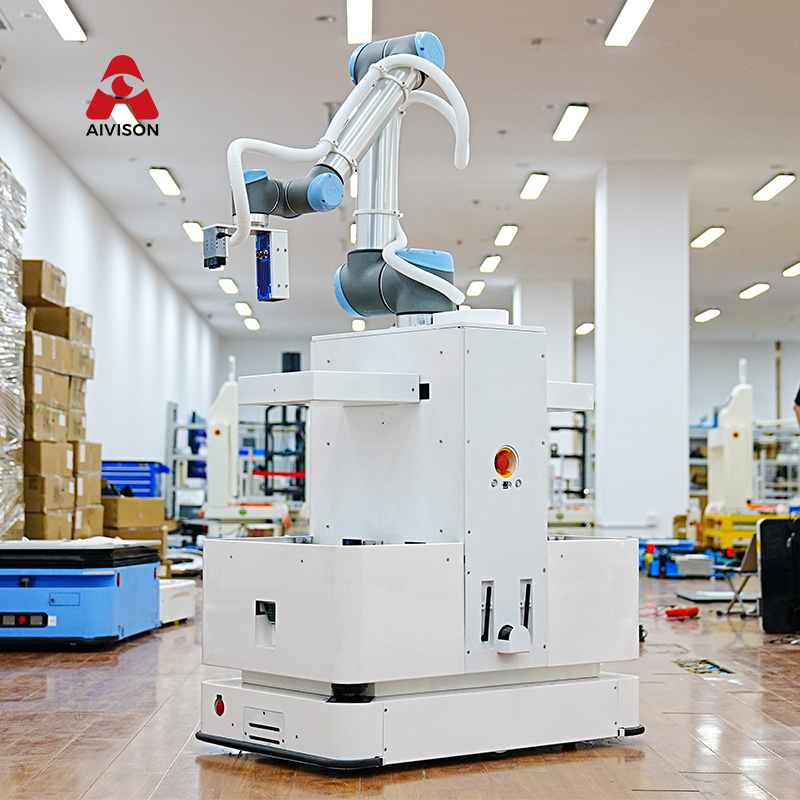The rise of Autonomous Mobile Robots (AMRs) is reshaping traditional manufacturing and logistics operations. Unlike conventional Automated Guided Vehicles (AGVs), which rely on fixed tracks or magnetic tapes, AMRs leverage AI, sensors, and real-time mapping to navigate dynamically. This shift brings significant improvements in efficiency, flexibility, and cost-effectiveness.

1. Enhanced Operational Efficiency
- Reduced Downtime: AMRs operate 24/7 without breaks, minimizing production delays.
- Faster Material Handling: They optimize routes in real-time, reducing travel time by 30–50% compared to manual or AGV systems.
- Just-in-Time (JIT) Logistics: AMRs enable seamless material flow between workstations, supporting lean manufacturing.
2. Flexibility & Scalability
- No Infrastructure Changes: Unlike AGVs, AMRs require no floor markers or fixed paths, allowing quick deployment.
- Adaptability: They reroute instantly if obstacles (e.g., workers, pallets) are detected, avoiding bottlenecks.
- Easy Reconfiguration: Factories can modify workflows without costly re-engineering (e.g., seasonal demand shifts).
3. Labor Optimization
- Reduced Manual Labor: AMRs automate repetitive transport tasks, freeing workers for higher-value roles (e.g., quality control).
- Safer Workflows: With collision-avoidance systems, AMRs reduce workplace accidents caused by human-operated forklifts.
4. Cost Savings
- Lower Deployment Costs: No need for magnetic strips or guide rails (unlike AGVs).
- Energy Efficiency: Many AMRs use rechargeable batteries with autonomous docking, cutting energy waste.
5. Data-Driven Improvements
- Real-Time Analytics: AMRs collect data on movement patterns, helping optimize factory layouts and workflows.
- Predictive Maintenance: Sensors detect mechanical issues before failures occur, minimizing unplanned downtime.
6. Global Innovations & Industry Trends
Recent advancements and corporate initiatives highlight the accelerating adoption of AMRs worldwide:
- Amazon’s New “Hercules” AMRs: In September 2023, Amazon announced a massive rollout of its next-generation Hercules robots across U.S. and European warehouses. These AMRs feature enhanced AI vision for handling irregularly shaped items, boosting inventory processing capacity by 35%.
- Siemens’ Smart Factory Integration: Siemens has partnered with Teradyne’s Mobile Industrial Robots (MiR) to deploy AMRs with 5G-enabled digital twins, allowing real-time simulation and optimization of robot fleets in its Singapore smart factory.
- Tesla’s Gigafactory Automation: Tesla reported a 20% reduction in vehicle assembly time at its Berlin Gigafactory after integrating 150 AMRs from Omron to autonomously transport battery packs, streamlining production bottlenecks.
- Mergers & Acquisitions: The AMR market is consolidating rapidly. In July 2023, Rockwell Automation acquired AMR startup Autonomous Solutions Inc. (ASI) for $200M, aiming to strengthen its end-to-end industrial automation portfolio.
- Regulatory Shifts: The EU’s new Machinery Regulation 2023/1230, effective 2024, mandates stricter safety standards for collaborative robots (including AMRs), accelerating innovation in sensor-based human-robot interaction technologies.
These developments underscore AMRs’ growing role not just as tools, but as central pillars of the Industrial Metaverse and sustainable manufacturing initiatives.
Case Examples
- Automotive: BMW uses AMRs to deliver parts to assembly lines, reducing wait times by 25%.
- E-Commerce: Amazon’s warehouses deploy AMRs for “goods-to-person” picking, boosting order fulfillment speed.
Challenges & Future Trends
While AMRs offer immense benefits, challenges include:
- High initial investment (though ROI is achieved within 1–3 years).
- Integration with legacy systems in older factories.
Future advancements in 5G connectivity, swarm robotics, and AI will further enhance AMR capabilities, making them indispensable for smart factories.
Conclusion
AMRs are not just replacing AGVs—they’re redefining factory efficiency. By enabling autonomous, adaptable, and data-powered logistics, they help manufacturers stay competitive in Industry 4.0. Companies adopting AMRs today will lead in productivity, agility, and cost savings tomorrow.
